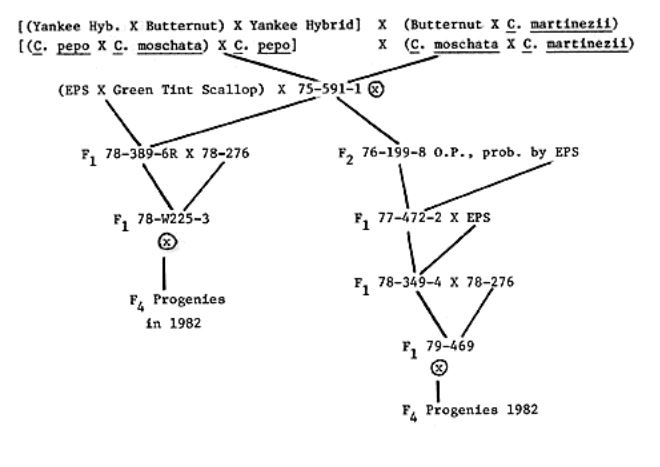Cucurbit Genetics Cooperative Report 6:82-83 (article 41) 1983
Henry M. Munger and Richard L. Washek
Cornell University, Ithaca, NY 14853
After many years of attempting to use cucumber mosaic resistance derived from PI 176959, a C. pepo from Turkey, recent efforts have concentrated on C. martinezii which is proving a far better source of resistance. Nevertheless, 3 lines derived from crosses with PI 176959 have been extremely useful in two ways: 1. As parents in complex crosses which also involve C. martinezii and 2., as checks for evaluating levels of resistance. The latter use may be the more important. Many levels of reaction to CMV exist in C. pepo and these unfortunately are expressed as drastic differences from one test to another rather than as gradations in symptom expression in a given test. We have come to use six varieties and breeding lines as checks in most CMV-inoculated plantings to evaluate the level of resistance in newer lines. They are ranked from most susceptible to most resistant in the following list:
- ‘Early Prolific Straightneck’ (EPS). Uniformly susceptible in all tests. Highly stunted or killed when inoculated at any age. Usually severely affected from natural infection in field at Ithaca, NY.
- ‘Zucchini’ and ‘Caserta’. Usually as badly stunted as EPS when inoculated at cotyledon stage, especially in the greenhouse from fall to early spring. Hard to infect as plants become older. When grown in the field without artificial inoculation, they are sometimes severely stunted and mottled but in other seasons are essentially unaffected by CMV while EPS nearby is stunted or killed. They sometimes look healthy through most of the season but die suddenly toward the end after producing several fruits. ‘Caserta’ sometimes survives when ‘Zucchini’ does not, but the average difference is not great.
- 78-274 and 78-276. F5 progenies from [(PI176959 x Yankee Hybrid) F5 x EPS x EPS]. Plant and fruit type similar to EPS. Variable reaction to CMV much as described for ‘Zucchini’ and ‘Caserta’ but usually less affected than those varieties. When grown in the field at Ithaca without artificial inoculation, they usually produce a crop while EPS fails. However, in a late-planted farm test near Albany, NY, these lines looked no more resistant than EPS. While infection with a different virus is not entirely ruled out as an explanation, we conclude that their resistance to cucumber mosaic is too risky for New York conditions and try to eliminate progenies of this level. They are useful as parents to improve EPS type without going back to the completely susceptible EPS; all our present lines of EPS type have one of these in their parentage.
- 73-604. F8 progeny from PI 176959 x ‘Yankee Hybrid’ (3) used as parent in 1966 to start the backcross progenies just described. A viney plant with short cylindrical tan fruit. Almost never shows symptoms from natural infection in the field and after young seedlings are inoculated for field plantings, most plants show only slight symptoms. Some runners may show severe symptoms when fruit is maturing. Some plants may show strong symptoms in early inoculated greenhouse tests but these show marked recovery and many show only slight or no symptoms. This has been our most resistant check line; its level of resistance seems fully adequate for any situations we have encountered in growing summer squash.
- Two families designated as 469 and W225 are of more recent origin, include in their parentage both C. martinezii and 78-276 (listed under 3 above) and constitute our most advanced material with a uniformly high level of CMV resistance. Numerous F4 lines of both families were grown in 1982 and some seem to be true-breeding for even higher CMV resistance than 73-604 (number 4 in list above).
Both are recognizably of summer straightneck fruit type but vary in shape and wartiness. Both have plants that are slightly less compact than summer squash and W235 has distinctive mottled leaves. The 469 family is susceptible to powdery mildew while the W225 has some highly PMR plants.
We encourage anyone interested in CMV resistance in C. pepo to obtain seed of the above lines to compare with the resistance of their own material, to evaluate the severity of natural infection, or to use as parents.
The parentage of the 469 and W225 families is given below. In this diagram a series of 2 numbers designates a row while 3 numbers designates a single plant. 75-591-1 was a plant selected for powdery mildew resistance by Contin (1, 2) from the complex hybrid he made, using as female parent the interspecific backcross population developed by Wall & York (4) and maintained at Cornell by periodic isolated increase.
Figure 1. The parentage of the 469 and W225 families
Literature Cited
- Contin, Maximo E. 1978. Interspecific transfer of powdery mildew resistance in the genus Cucurbita. Ph.D. Thesis, Cornell University.
- Contin, M. and H. M. Munger. 1977. Inheritance of powdery mildew resistance in interspecific crosses with Cucurbita martinezii. (Abstr.) HortScience 12:29.
- Martin, Mark W. 1959. Inheritance and nature of cucumber mosaic virus resistance in squash. Ph.D. Thesis, Cornell University.
- Wall, J. R. and T. L. York. 1960. Gametic diversity as an aid to interspecific hybridization in Phaseolus and in Cucurbita. Proc. Amer. Soc. Hort. Sci. 75:419–428.
